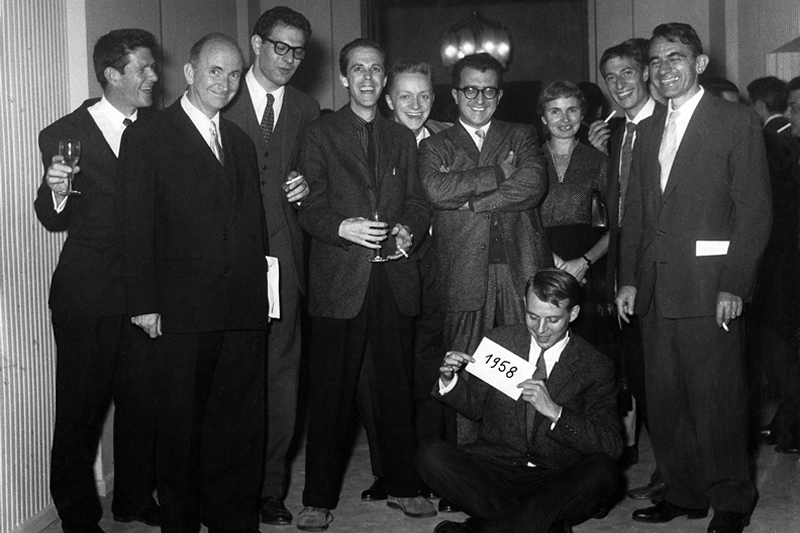
Instrumentation Works for Orchestra
Stockhausen Complete Edition on CD
Since 1991, a complete edition of all recordings in which Karlheinz Stockhausen has personally participated is being released on compact discs. Each CD in this series is identified by Stockhausen's signature followed by an encircled number. The numbers indicate the general historical order of the works.
Stockhausen realised the electronic music and participated in these recordings as conductor, performer, sound projectionist, and musical director. He personally mixed down the recordings, mastered them for CDs, wrote the texts and drew the covers.
- The compact discs may be obtained from the Stockhausen-Verlag: Kettenberg 15, 51515 Kuerten, Germany (www.stockhausenCDs.com).
Karlheinz Stockhausen
Instrumentation Works for Orchestra
PUNKTE / POINTS
Orchestra
| 3 flutes (all 3 also piccolo, 3rd also alto flute) |
| 3 oboes (1st also oboe d'amore, 3rd also english horn) |
1 piccolo clarinet ( in  ) ) |
1 clarinet ( in  ) ) |
| 1 bass clarinet |
| 3 bassoons (3rd also contra-bassoon) |
| 3 horns (1st high, 2nd middle, 3rd low) with mutes |
| 3 trumpets each trumpeter and each trombonist has three mutes (choose special sizes for bass trombone) pointed mute / cup mute / wawa mute:  covered by the hand covered by the hand open open  continuous transitions from continuous transitions fromcovered to open and vice vera |
| 1 tenor trombone each trumpeter and each trombonist has three mutes (choose special sizes for bass trombone) pointed mute / cup mute / wawa mute:  covered by the hand covered by the hand open open  continuous transitions from continuous transitions fromcovered to open and vice vera |
| 1 bass trombone (or tenor trombone with bass valve) each trumpeter and each trombonist has three mutes (choose special sizes for bass trombone) pointed mute / cup mute / wawa mute:  covered by the hand covered by the hand open open  continuous transitions from continuous transitions fromcovered to open and vice vera |
| 1 bass tuba (with mute) |
2 pianos (2nd also celesta) |
| 2 harps |
| 3 percussionists: 1st: tubular chimes, glockenspiel, 2 pedal timpani (high, low) |
2nd: vibraphone  hard mallets or sticks hard mallets or sticks soft mallets or sticks soft mallets or sticksuse various kinds of hard and soft mallets and sticks according to the directions of the conductor |
3rd: marimbaphone  hard mallets or sticks hard mallets or sticks soft mallets or sticks soft mallets or sticksuse various kinds of hard and soft mallets and sticks according to the directions of the conductor |
| 8 1st violins all soloistic |
| 8 2nd violins all soloistic |
| 8 violas all soloistic |
| 6 cellos all soloistic |
| 4 basses all soloistic |
All notes sound as written. An accidental (  ,
,  ,
,  ) applies only to the note before which it stands.
) applies only to the note before which it stands.
Supplement – PUNKTE (POINTS) for Orchestra
1) the two harps with 2 microphones each: one placed low and one
high next to the strings;
2) the two pianos (without lids!) with 2 microphones each: one placed over
the highest octave, and the other one next to it pointed diagonally towards the
lower strings and aimed at C1 
3) the 4 double-basses with one microphone each.
4) The conductor and sound projectionist should be able to communicate
with the orchestra and with each other via 2 transmitters. For this they also
need 2 monitor loudspeakers on the stage and one at the mixing console.
In the middle of the hall, a sound projectionist at a small mixer (14 → 2) controls the dynamic balance between these instruments and the orchestra, as well as the dynamic level of the transmitters.
For the amplification, 2 x 2 loudspeakers are suspended about 4 m high at the left and right sides of the orchestra:
The amplification of the instruments mentioned is also necessary during the rehearsals.